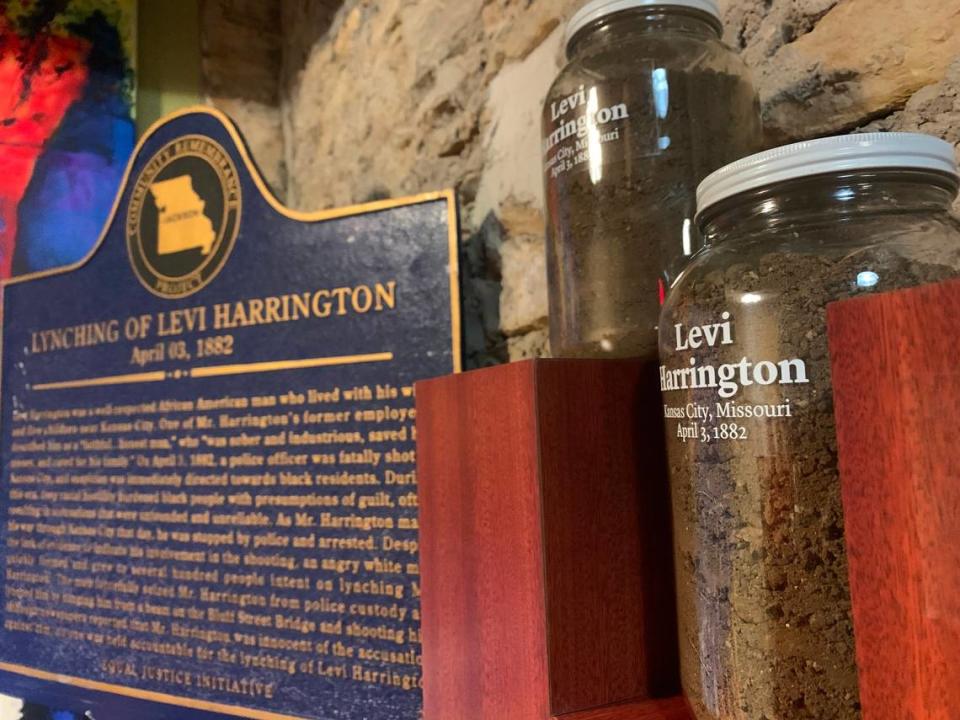Levi Harrington’s 1882 lynching memorialized with soil collection, funeral procession
Christine Peoples’ voice rang out through the rain as the two jars behind her were filled with dirt one spade full at a time.
“When Sunday comes, the Lord will soothe my troubled mind,” Peoples sang as the wind howled, threatening to blow umbrellas away.
The dirt was pulled from the patch of earth — as close as possible — of the lynching of 23-year-old Levi Harrington from the then-Bluff Street Bridge nearly 140 years ago. These jars of dirt from this uneasy ground would soon be on their way to the Black Archives of Mid-America in the historic 18th and Vine District where they will sit as a poignant and painful reminder of Kansas City’s past.
One by one, each of the at least 50 people in attendance on the gloomy Saturday afternoon stepped forward and scooped dirt into each jar.
The event, organized by the Community Remembrance Project of Missouri in partnership with the Equal Justice Initiative, was meant to memorialize Harrington and ensure the fight against racism and injustice continues. They aim to collect 60 jars of soil from Missouri’s lynching sites.
The group first collected soil from the ground in December 2018. The temperature then was probably about 2 degrees, joked Glenn North, executive director of the Bruce R. Watkins Cultural Center. But the discomfort felt that day, and in the rain Saturday, is fitting, North said.
“If things are ever going to change, we have to become comfortable with being uncomfortable,” North told the group.
He added: “We are here today to stand up and to speak up, to fight racism and injustice. So that Levi Harrington did not die in vain.”
On April 3, 1882, a police officer saw two Black men walking down the street with large containers. He chased them into a vacant lot. One of the men shot and killed the officer. Harrington was in the area at the time, blamed for the killing and arrested.
A mob of anywhere between 300 to 700 people seized Harrington from police custody, wrapped a rope around his neck and flung him over the bridge. Someone in the mob shot him several times.
Harrington was later found to be innocent. No one was convicted in his death.
“When Sunday comes, my trouble gone,” Peoples sang. She is the Timmons Hall history and community engagement coordinator with the Springfield-Greene County Park Board. “As soon as it gets here, I’ll have a new song.”
With the jars filled, the Rev. Stacy R. Evans, a pastor at Allen Chapel African Methodist Episcopal Church, gave a brief history of the country’s chattel slavery. In that form, enslaved people belonged to slave owners and their children remained enslaved. Black people, Evans said, were not considered human.
“So that’s the challenge we’re up against,” Evans told the group. “Not just rights, but that Black people be considered human, so that we can have rights to fulfill our dreams and lives that we were born into by God.”
After a funeral procession to the Mid-America Black Archives, the jars were placed on display next to the large plaque memorializing Harrington’s killing that had been removed from its West Terrace Park home following vandalism.
Inside the archives, Alvin Brooks — one of Kansas City’s most beloved civic leaders — told those assembled that he could feel the hurt.
“When an injustice takes place ... that should be pain for all of us,” Brooks said, a jazz band playing outside. He called on people to make systemic changes to a racist system. Without that, Brooks said, “in 50 to 100 years we’ll still be talking about the same thing.”
City manager Brian Platt briefly spoke to the group, saying that it’s important to constantly be working to make things better and to remember the significance of an event from 140 years ago.
“One day George Floyd will be 140 years away,” he said. “There’s always something that happens in the community, that reminds us that our work is not yet done.”
A trial is ongoing for former Minneapolis police officer Derek Chauvin, who was charged with murder and manslaughter in Floyd’s May 25 death. Video shows Chauvin placing his knee on Floyd’s neck for 9 1/2 minutes while Floyd, facedown, hands cuffed behind him, cried out that he couldn’t breathe. His death led to protests across the country. In Kansas City, hundreds turned out.
Staci Pratt, the co-liaison to the Equal Justice Initiative with the Community Remembrance Project, said it’s important to talk about the truth of history to memorialize the past and to change the present.
“There is a deep connection between the historic and entrenched patterns of violence against members of the African American community and our current failure to value Black lives,” Pratt said.
Three years ago, they collected soil to send to the Legacy Museum in Alabama. That same day, the group put up a memorial marker in honor of Harrington. That marker was removed in June after someone cut it from its pole and threw it off a cliff. Now, it rests beside the jars of soil.
Carmaletta M. Williams, executive director of the Black Archives, said the turnout at Saturday’s event showed that the community wants to heal.
“They don’t like this condition,” Williams said, “and especially when it’s rooted in such horrific circumstances ... That’s what this event is about: making steps toward racial healing.”
As the speakers wrapped up, the band playing outside marched through the museum, filling the air with the pulse of drums and the flit of trumpets, while the jars were placed in their new home.
As they marched back through the doors and out into the street, people broke out into dance — a celebration.

 Yahoo Finance
Yahoo Finance 

